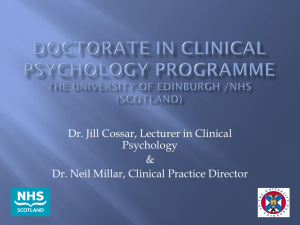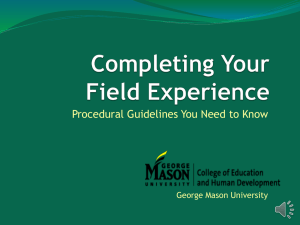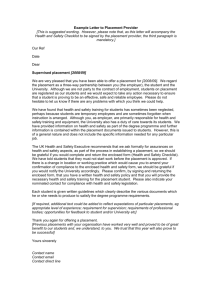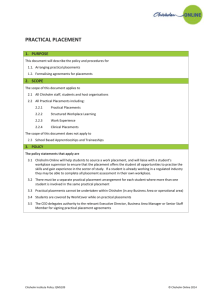Reflections on practitioner research
advertisement
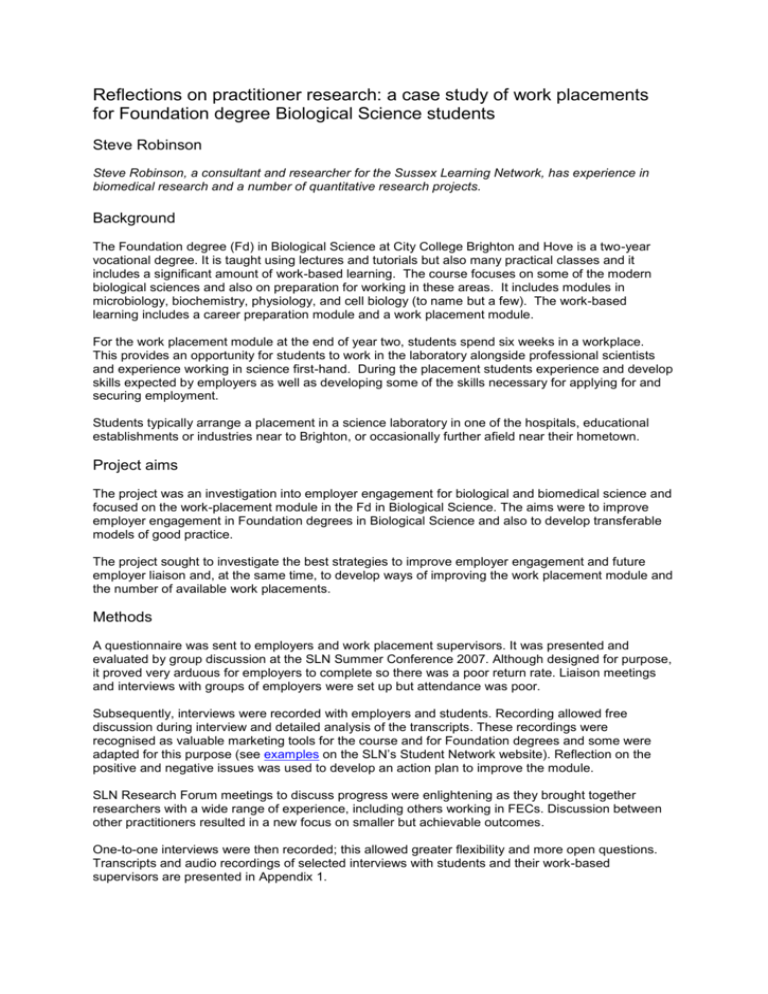
Reflections on practitioner research: a case study of work placements for Foundation degree Biological Science students Steve Robinson Steve Robinson, a consultant and researcher for the Sussex Learning Network, has experience in biomedical research and a number of quantitative research projects. Background The Foundation degree (Fd) in Biological Science at City College Brighton and Hove is a two-year vocational degree. It is taught using lectures and tutorials but also many practical classes and it includes a significant amount of work-based learning. The course focuses on some of the modern biological sciences and also on preparation for working in these areas. It includes modules in microbiology, biochemistry, physiology, and cell biology (to name but a few). The work-based learning includes a career preparation module and a work placement module. For the work placement module at the end of year two, students spend six weeks in a workplace. This provides an opportunity for students to work in the laboratory alongside professional scientists and experience working in science first-hand. During the placement students experience and develop skills expected by employers as well as developing some of the skills necessary for applying for and securing employment. Students typically arrange a placement in a science laboratory in one of the hospitals, educational establishments or industries near to Brighton, or occasionally further afield near their hometown. Project aims The project was an investigation into employer engagement for biological and biomedical science and focused on the work-placement module in the Fd in Biological Science. The aims were to improve employer engagement in Foundation degrees in Biological Science and also to develop transferable models of good practice. The project sought to investigate the best strategies to improve employer engagement and future employer liaison and, at the same time, to develop ways of improving the work placement module and the number of available work placements. Methods A questionnaire was sent to employers and work placement supervisors. It was presented and evaluated by group discussion at the SLN Summer Conference 2007. Although designed for purpose, it proved very arduous for employers to complete so there was a poor return rate. Liaison meetings and interviews with groups of employers were set up but attendance was poor. Subsequently, interviews were recorded with employers and students. Recording allowed free discussion during interview and detailed analysis of the transcripts. These recordings were recognised as valuable marketing tools for the course and for Foundation degrees and some were adapted for this purpose (see examples on the SLN’s Student Network website). Reflection on the positive and negative issues was used to develop an action plan to improve the module. SLN Research Forum meetings to discuss progress were enlightening as they brought together researchers with a wide range of experience, including others working in FECs. Discussion between other practitioners resulted in a new focus on smaller but achievable outcomes. One-to-one interviews were then recorded; this allowed greater flexibility and more open questions. Transcripts and audio recordings of selected interviews with students and their work-based supervisors are presented in Appendix 1. Results Employer views Employer views on the Fd work placements suggested that the timing of the placements (May to June) and their length (six weeks) were appropriate to allow performance to proficiency and obtain learning outcomes. However, in some cases, the employers said they were unable to offer a placement for such a long period. It may be worthwhile exploring a shorter placement, as with the University of Brighton Foundation degree in Business (here a two-week placement is the norm). Nearly all work placement supervisors said that they would like to employ the students. This was surprising since most employers had initially been very reluctant to take students on placement. Male students were slower than their female counterparts in securing work placements; at one stage all the latter were placed but none of the former. Virtually all students received very positive feedback from employers, and employers were keen to employ them. The interviews demonstrated that employers do respond to and support curriculum developments but that they have limited capacity to attend meetings at college and write modules. Visiting them in their workplace is a good model for engagement; there are resource implications but these are minimised if multiple tasks are completed during visits. Most employers prefer academic rather than laboratory skills to be the outcome of Fdcourses. This finding was unexpected, particularly as the Fd in Biological Science has been designed to include many practical skills required in traditional laboratory work. Rather than having practical skills (that can be taught on the job) employers want trainees to know about the background to health and disease so that they can interpret data. It is interesting to note that while some students enjoyed working in a fully automated diagnostic lab for their work placement, others found it rather repetitive and boring. Access to up-to-date automated diagnostic technology is not available at City College Brighton & Hove or the University of Brighton so the placements give a valuable opportunity to experience them. The interviews revealed differences between Biomedical Science (BMS) laboratory specialisms, for example between training requirements at pre-registration level (bands 2–4) for haematology and microbiology. NHS training and career structures are also complex. Training staff and new qualifications will not automatically allow movement up the career band and a change of role (promotion posts need to be available first). See article 5.4 for more discussion of this issue <link>. Student views Evaluation from Year 2 students showed that the placement module was very well received but, surprisingly, not as popular as other taught modules. This could be because the module is demanding in terms of student activity. The evaluation of the placement was collected during student presentations and was skewed by negative feedback from a student whose placement was eventually terminated by the employer. A questionnaire designed for Year 1 demonstrated that 83% of students had given little thought to their placement by the end of Year 1, although 17% of students had started enquiring. The Student Network website presents case studies of students who completed placements and the Fd in 2007/8, recorded during a visit three to four weeks into the work placement. They clearly show how both students and employers have benefited from the work placement, and they also give insights into the advantages of studying a Fd and the progression routes. (See Appendix 1 for examples of student and employer views). Some students didn’t prepare for the placement until very late, and these students regretted not attending preparatory tutorials. One placement was terminated due to poor attendance and timekeeping. Responses from students at the end of Year 1 show a need to improve their preparation by linking the Year 1 career planning and common skills modules directly to the work placement. Aspirations by Fd Biomedical Science students to progress to study medicine were found to be common, particularly among overseas students. Whether these are realistic goals needs further investigation, as it may be appropriate to counsel these students towards the applied biomedical science degree. There is evidence that graduates perform better at medical school, but also evidence that performance is linked to A-level score, and most of these students have a relatively poor A-level score. Currently in the UK 10% of entrants to medical school are graduates. In an online article for the British Medical Journal, Ed Peile argued that the maturity and experience of independent study mean that graduates have very high completion rates at medical school (2007). The students were surprisingly positive about the placement and this inspired the idea that the interviews could be adapted to market the course and inform potential students of the benefits of work-based learning and Foundation degrees. This resource could be used to market the success stories to employers who have been reluctant to take placement students and prospective students. The effects on students’ career aspirations were often considerable, with one student changing her plans to train in physiotherapy to study the BSc in Applied Biomedical Science. In order to secure placements, motivation – and applications – should occur early in the year. Communication between the college tutor and placement students could also have been improved. Students were reluctant to keep in contact with the tutor, but communicated well with each other via Facebook. Should the college use Facebook rather than email in future? The involvement of a work-based supervisor in assessment is good practice for work-based learning. Currently, the standard interview and a short form are used qualitatively by the tutor to inform marking of the portfolio assignment. A number of supervisors said that, in future, they would be willing to formally assess parts of the placement. This should be explored. It would also be worth considering how the students can assess the supervisor and placement. The use of part-time jobs (not necessarily including biological laboratory work) could also be developed, since there are many careers in biology that are not lab-based. This would also offset the shortage of laboratory placements. The assessment criteria would need amendment to allow more flexibility. Differences between the sexes in securing placements warrants further investigation. The gap in educational achievement is well documented for younger age groups (boys are slower than girls to develop some skills). This raises the question: do males need additional support in securing placements? The two best-performing male students were asked if they knew why they had been slower to find placements. They thought this was coincidence and bad luck, and that they studied harder than most female students. Conclusions The employer and student feedback on work placement has been developed for marketing by the Sussex Learning Network. This will be particularly useful in highlighting the benefits of placements to employers previously unwilling to offer them, and also in encouraging new students to embark on a Foundation degree. It should also allow Year 1 students to focus early on their preparation to secure placements. Future research possibilities could include: evaluating several employers unable to offer placements this year quality improvement and response to the module feedback questionnaire an investigation into whether the aspirations of many Fd Biomedical Science students to progress to study medicine are realistic The work placement module has proved an excellent vehicle for improving employer engagement and liaison. It is a very successful and valuable experience for students and employers. It needs careful planning and management by tutors and students, which requires many skills. In future, placement visits should be combined with employer liaison wherever possible. Appendix 1: Example interviews with a placement student and their supervisor Transcript A: Interview with placement student Clementine Foulkes-Gazzard Listen to audio file (approximately two minutes) <link> SR: What are your feelings about the placement? CFG: Oh I’ve been loving it, I’m really, really enjoying it, it has been great. I think it’s quite interesting…one thing I’ve found really interesting is, how colleges can be so different. I’ve done teaching, I’ve done a bit photocopying, when I first started I made a load of [microscope] slides up of different staining, things like that, so that I then had to correspond these slides with already prepared slides that they could look at with the fact sheets –so it was almost like resource making, I suppose, so that was really good. I’ve done Bacillus cereus, I’ve done endospore staining, I’ve done gram staining on E coli. SR: Excellent. CFG: I made up a load of prepared slides on really interesting wine spiking yeasts and bacteria. I’d never heard of them before and that’s really good. It’s definitely helped, it’s given me much more of an insight into how everyday college practicals or school practicals would run, the amount of effort that has to go into just making resources, and obviously timetabling here is a huge issue…. It’s given me a whole view of what goes on in a normal college, in the college system, it’s definitely opened my eyes to the day-to-day running of it, rather than just thinking, I want to teach. It’s definitely given me a more on-hand, “in –there” SR: More of an insight into what goes on – CFG: - yes, into the system as a whole. It’s not just the theory side of it; the practicals and the placement are also relevant to the course I’m studying. It’s definitely worked out well for me, better than I thought actually. I didn’t think I would get so much practical work in as I have really, so I think that’s quite good. Transcript B: Interview with Clementine’s Supervisor - a Senior Laboratory Technician (SLT) at Plumpton College Listen to audio file <link> SR: What are your overall impressions of the placement student? SLT: She is absolutely lovely, she’s very willing, very diligent, highly organised, I don’t think there is anything negative, she’s very friendly and outgoing, and she’s actually fitted in very well. SR: Brilliant. SLT: I couldn’t have wished for a better placement student really. It’s very - I am the only lab technician here, so for someone just interested in the technical side, it may have been difficult for them, but because she wants to teach, she’s been going out to the classrooms and acting as a lab support to the lecturers, which has worked very well, and the lecturers are very pleased with her too. References Peile, E. (2007). Should all medical students be graduates first? Yes. British Medical Journal 2007;335:1072 (24 November), doi:10.1136/bmj.39283.476725.BE. Available at: http://www.bmj.com/cgi/content/full/335/7629/1072



